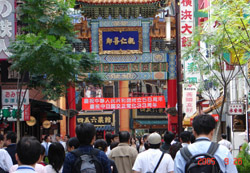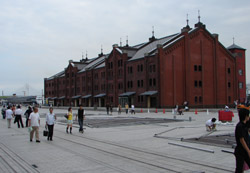Archilife Investingating Mission for SB05Tokyo (5) (Part: 2)
 第二站參觀橫濱中華街,除於當地享用午餐外,也從經濟角度及文化融合方向來探討都市發展行為。這裡匯集了堪稱世界最大規模500餘家以上的飲食店和雜貨店,街區以紅黃色裝飾為主調,構成了橫濱市內的異國情調。中華街區內供奉三國時代英雄人物關羽為「商賈之神」,這座廟宇雕樑畫棟、輝煌壯麗,是中華街的象徵。以紅色和金色為基調的善鄰門,金碧輝煌、絢麗多彩,在中華街眾多的牌樓中最為搶眼出眾。善鄰之意是表達與近鄰、鄰國和睦相處。中華街的牌樓根據風水設計(東為青龍神、南為朱雀神、西為白虎神、北為玄武神),北為玄武門、西為延平門、南為朱雀門、東為朝陽門(臨時設立),各自鎮守四方。 第二站參觀橫濱中華街,除於當地享用午餐外,也從經濟角度及文化融合方向來探討都市發展行為。這裡匯集了堪稱世界最大規模500餘家以上的飲食店和雜貨店,街區以紅黃色裝飾為主調,構成了橫濱市內的異國情調。中華街區內供奉三國時代英雄人物關羽為「商賈之神」,這座廟宇雕樑畫棟、輝煌壯麗,是中華街的象徵。以紅色和金色為基調的善鄰門,金碧輝煌、絢麗多彩,在中華街眾多的牌樓中最為搶眼出眾。善鄰之意是表達與近鄰、鄰國和睦相處。中華街的牌樓根據風水設計(東為青龍神、南為朱雀神、西為白虎神、北為玄武神),北為玄武門、西為延平門、南為朱雀門、東為朝陽門(臨時設立),各自鎮守四方。The Yokohama Chinatown was the second stop of the tour. Besides having lunch there, we also investigated the urban development behavior there in terms of economics and cultural fusion. In fact, it is known as the biggest Chinatown in the world with over 500 Chinese restaurants and grocery stores. The street is basically in red and yellow, forming an exotic mood in the city of Yokohama. People in the Chinatown worship General Guan Yu, a hero of the Period of Three Kingdoms, as the god of merchant. As the landmark of the Chinatown, the temple where General Guan Yu is worshipped has magnificent beams and painted columns, brilliant and splendid. The red-and-golden-colored Shanlin Arch is resplendent and magnificent, bright and colorful. It is the most eye-catching archways in Yokohama Chinatown. The meaning of shanlin in Chinese refers to being friendly and kind to your neighbors. Archways in the Chinatown were designed according to geomancy (fensui) green Dragon God in the east, Rosefinch God in the south, White Tiger God in the west, and Shuanwu God in the north. The four archways surrounding the Chinatown are the Shuanwu Arch in the north, Yenping Arch in the west, Chuche Arch in the south, and Jaoyan Arch (temporary) in the east, guarding the city from all around.  離開橫濱中華街後,考察團驅車參訪舊建築局部更新後再利用的成功案例:紅磚屋倉庫(Yokohama Red Brick Warehouse),紅磚屋倉庫為明治、大正時代的磚造建築,沿襲其受人青睞的外觀不變,內部景觀卻煥然一新。紅磚屋倉庫共有兩棟,編號分別為1號館及2號館,1號館有大廳、多功能場地,做為藝文表演、畫廊、藝術展示館及各種演講用,館內安排有定期藝文表演活動;2號館有音樂伴奏餐廳和啤酒餐廳,另外還有31家餐館和紀念精品商店,因適當的規劃及裝修,平時及假日旅客及參觀人潮不斷,另周圍是大片廣場及鄰近綠樹成蔭的公園,則是休閒的好去處,故有相當不錯的商業交易活動。離開紅磚屋倉庫後考察團來到最後一站,鄰近的橫濱山下公園,在公園內可以遠眺橫濱海灣大橋和橫濱港口內穿梭來往的船隻,保養維護良好的草坪、配置良好的植栽及適當的街道傢俱充滿了浪漫溫馨的氛圍。公園內有穿紅鞋子的少女塑像、印度水塔及美國聖地牙哥市贈送的護水神像等,印證橫濱和世界各國廣泛交流及為深度文化交融之港灣都市。 離開橫濱中華街後,考察團驅車參訪舊建築局部更新後再利用的成功案例:紅磚屋倉庫(Yokohama Red Brick Warehouse),紅磚屋倉庫為明治、大正時代的磚造建築,沿襲其受人青睞的外觀不變,內部景觀卻煥然一新。紅磚屋倉庫共有兩棟,編號分別為1號館及2號館,1號館有大廳、多功能場地,做為藝文表演、畫廊、藝術展示館及各種演講用,館內安排有定期藝文表演活動;2號館有音樂伴奏餐廳和啤酒餐廳,另外還有31家餐館和紀念精品商店,因適當的規劃及裝修,平時及假日旅客及參觀人潮不斷,另周圍是大片廣場及鄰近綠樹成蔭的公園,則是休閒的好去處,故有相當不錯的商業交易活動。離開紅磚屋倉庫後考察團來到最後一站,鄰近的橫濱山下公園,在公園內可以遠眺橫濱海灣大橋和橫濱港口內穿梭來往的船隻,保養維護良好的草坪、配置良好的植栽及適當的街道傢俱充滿了浪漫溫馨的氛圍。公園內有穿紅鞋子的少女塑像、印度水塔及美國聖地牙哥市贈送的護水神像等,印證橫濱和世界各國廣泛交流及為深度文化交融之港灣都市。Leaving the Chinatown of Yokohama, the delegation continued the trip to the Yokohama Red Brick Warehouse, a successful case of the reuse of part of an abandoned building. The warehouse was a brick structure built during the Meiji and Taisho periods. The reconstruction didn't change anything on the warehouse appearance, though the interior was completely new. There are two buildings, Warehouse I and Warehouse II. Inside Warehouse I, there are hall and multifunctional venues for speeches and art exhibitions. In fact, the Warehouse itself holds various cultural activities regularly. Inside Warehouse II, there are a live-band restaurant, a beer restaurant, and 31 restaurants and souvenir shops. Due to the proper planning and decoration, there are countless visitors on both weekdays and holidays. The huge plaza and green parks around warehouses are ideal places for leisure. Therefore, business activities are quite vigorous there. The Yamashita Park was the last stop of our Yokohama one-day tour. Located near the Yokohama Red Brick Warehouse, people can have a good vista of the Yokohama Bay Bridge and vessels coming in and out the port from the park. With the well-maintained lawn, well-laid plantation and proper rampant furniture, the atmosphere of the park was warm and tender. Other monuments in the park included the statue of the girl in red shoes, the Indian water tank, and the water god statue presented by San Diego, USA. These have witnessed that Yokohama is a bay city with frequent exchange and cultural fusions with foreign countries. |

